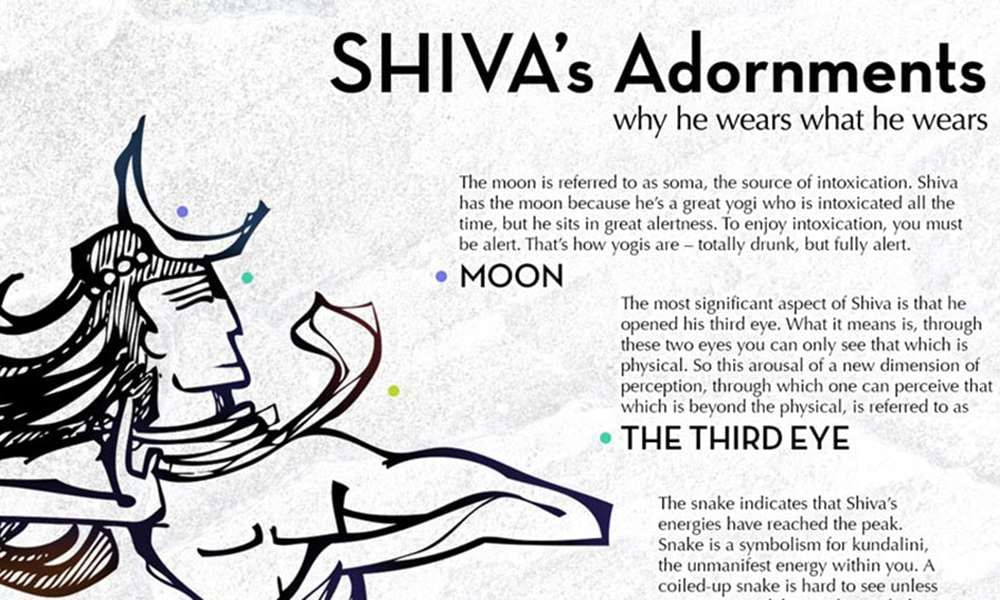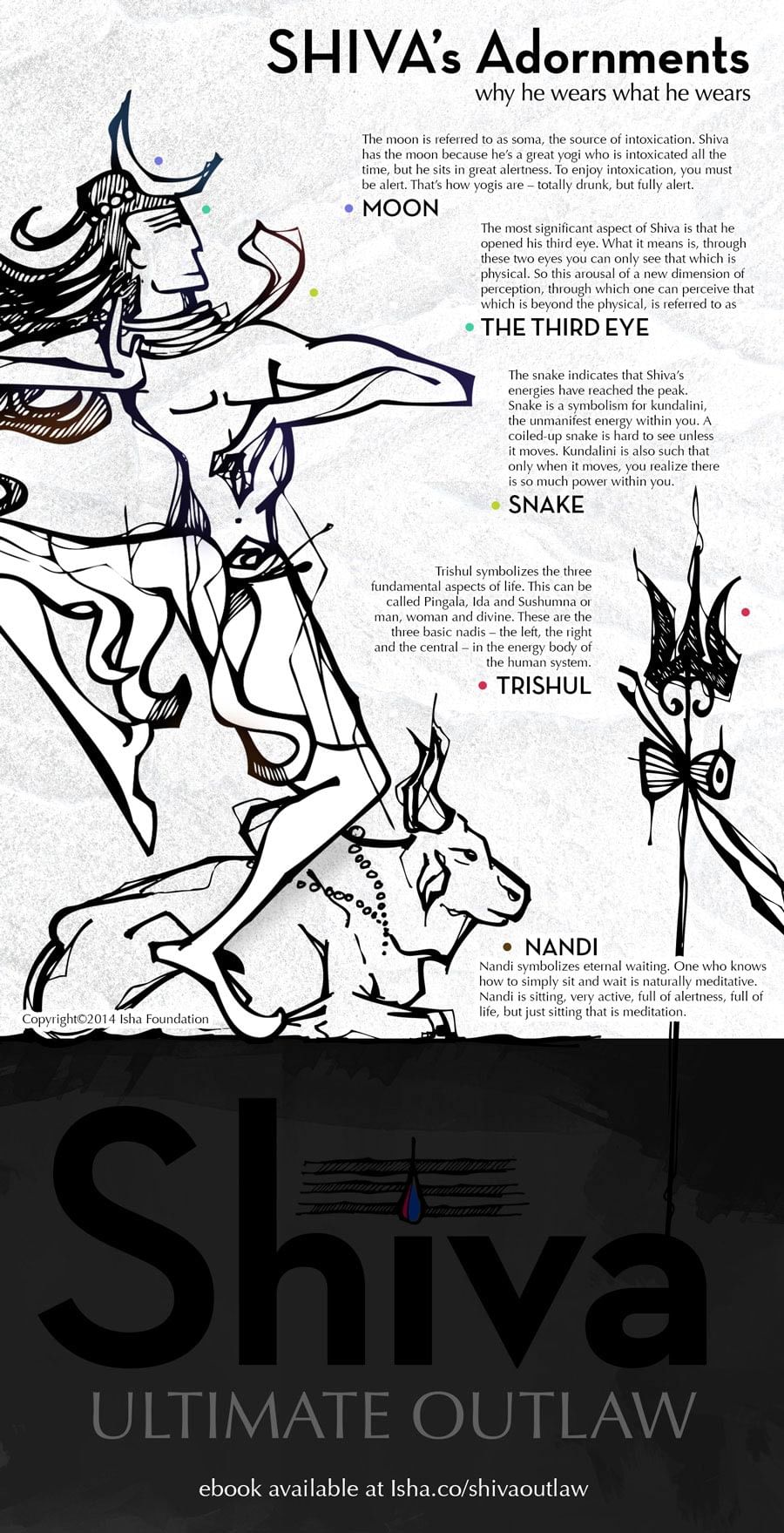Shiva’s Adornments – The Symbols and Symbolism of Shiva
What’s the meaning of the snake around Shiva’s neck? Why does he have a moon on his head? Let’ take a look at the adornments and symbols of Shiva.

What’s the meaning of the snake around Shiva’s neck? Why does he have a moon on his head? What is the significance of all this symbolism? In the third part of the series “Getting to Know Shiva,” yogi and mystic, Sadhguru, takes a look at the adornments and symbols of Shiva. The first two parts looked at who Shiva is and four significant places in India where Shiva has spent time. These posts are excerpts from Sadhguru’s latest book, “Shiva – Ultimate Outlaw.” Pay what you want and get it.
Click Image to Enlarge
Third Eye
Sadhguru: Shiva has always been referred to as Triambaka because he has a third eye. The third eye does not mean someone’s forehead cracked and something came out! It simply means another dimension of perception has opened up. If your perception has to evolve and enhance itself, the most important thing is that your energy has to evolve and enhance itself. The whole process of yoga is to evolve and refine your energies in such a way that your perception is enhanced and the third eye opens.

Subscribe
The third eye is the eye of vision. The two physical eyes are just sensory organs. They feed the mind with all kinds of nonsense, because what you see is not the truth. You see this person or that person and you think something about him, but you are not able to see the Shiva in him. You see things the way it is necessary for your survival. Another creature sees it another way, as is necessary for its survival. This is why we say this world is maya. Maya means it is illusory. We are not saying that existence is illusory. We are only saying the way you are perceiving it is illusory. So another eye, an eye of deeper penetration, has to be opened up. The third eye means your perception has gone beyond the dualities of life. You are able to see life just the way it is, not just the way that is necessary for your survival.
Nandi
Sadhguru: Nandi is a symbolism of eternal waiting, because waiting is considered the greatest virtue in Indian culture. One who knows how to simply sit and wait is naturally meditative. Nandi is not expecting Shiva to come out tomorrow. He is not anticipating or expecting anything. He is just waiting. He will wait forever. That quality is the essence of receptivity. Before you go into a temple, you must have the quality of Nandi – to simply sit. You are not trying to go to heaven, you are not trying to get this or that – you simply sit.
People have always misunderstood meditation as some kind of activity. No – it is a quality. That is the fundamental difference. Prayer means you are trying to talk to God. Meditation means you are willing to listen to God. You are willing to just listen to existence, to the ultimate nature of creation. You have nothing to say, you simply listen. That is the quality of Nandi – he just sits, alert. This is very important – he is alert, not sleepy. He is not sitting in a passive way. He is sitting, very active, full of alertness, full of life, but just sitting – that is meditation.
Trishul

Sadhguru: Shiva’s trishul represents the three fundamental aspects of life. These are the three fundamental dimensions of life that are symbolized in many ways. They can also be called Ida, Pingala and Sushumna. These are the three basic nadis – the left, the right and the central – in the pranamaya kosha, or the energy body of the human system. Nadis are pathways or channels of prana in the system. There are 72,000 nadis that spring from the three fundamental ones.
The Pingala and Ida represent the basic duality in the existence. It is this duality which we traditionally personify as Shiva and Shakti. You can simply call it masculine and feminine. When I say masculine and feminine, I am not talking in terms of sex – about being male or female – but in terms of certain qualities in nature. You could say the logical and the intuitive aspect of you.
Bringing a balance between the Ida and Pingala will make you effective in the world; this will allow you to handle life aspects well. Most people live and die in Ida and Pingala. Sushumna, the central space, remains dormant. But Sushumna is the most significant aspect of human physiology. Life really begins only when energies enter into Sushumna. You attain to a new kind of balance, an inner balance where whatever happens outside, there is a certain space within you that never gets disturbed and cannot be touched by outside situations.
Moon
Sadhguru: There are many names for Shiva. One name that is very commonly used is Soma or Somasundara. Soma could literally mean the moon, but soma essentially means inebriation or intoxication. Shiva uses the moon as a decoration because he is a great yogi who is intoxicated all the time, but he sits in great alertness. To enjoy the intoxication, you must be alert. Even when you drink, you try to stay awake and enjoy the intoxication. And that is how yogis are – totally drunk, but fully alert.

The science of yoga gives this pleasure to you to be internally drunk all the time, but one hundred percent stable and alert. There has been a lot of research in the last couple of decades, and a particular scientist found that in the human brain, there are millions of cannabis receptors. If you simply keep your body in a certain way, the body will produce its own narcotic, and the brain is waiting to receive it. It is only because the human body produces its own narcotic that feelings of peace, pleasure and joy can happen within you without any stimulus from outside.
When the scientist wanted to give this chemical an appropriate name, he came down to India and found the word ananda, or bliss. So he called it Anandamide. If you generate a sufficient amount of Anandamide in your system, then you can be drunk all the time, but fully awake, wide awake.
Snake
Sadhguru: A snake is also very sensitive to certain energies. Shiva has the snake around his throat. It is not just symbolic. There is a whole lot of science behind it. There are 114 chakras in the energy body. Out of these 114, people are usually talking about the seven fundamental chakras in the system. Among these seven fundamental ones, the vishuddhi chakra is located in the pit of your throat. This particular chakra is very strongly associated with the snake. The vishuddhi is about stopping poison, and a snake carries poison. All these things are connected.
The word vishuddhi literally means “filter.” If your vishuddhi becomes powerful, you have the ability to filter everything that enters you. Shiva’s center is supposed to be vishuddhi, and he is also known as Vishakantha or Neelakantha because he filters all the poison. He doesn’t allow it to enter his system. Poisons are not necessarily that which you may consume through food. Poisons can enter you in so many ways: a wrong thought, a wrong emotion, a wrong idea, a wrong energy or a wrong impulse can poison your life. If your vishuddhi is active, it filters everything. It saves you from all these influences. In other words, once vishuddhi is very active, that person is so powerful within himself that whatever is around him does not influence him anymore. He is established within himself. He tends to become a very powerful being.
Editor's Note: Download Sadhguru's ebook, Shiva - Ultimate Outlaw, along with Vairagya, an album of sacred chants (also available as an Android App). They're free!




